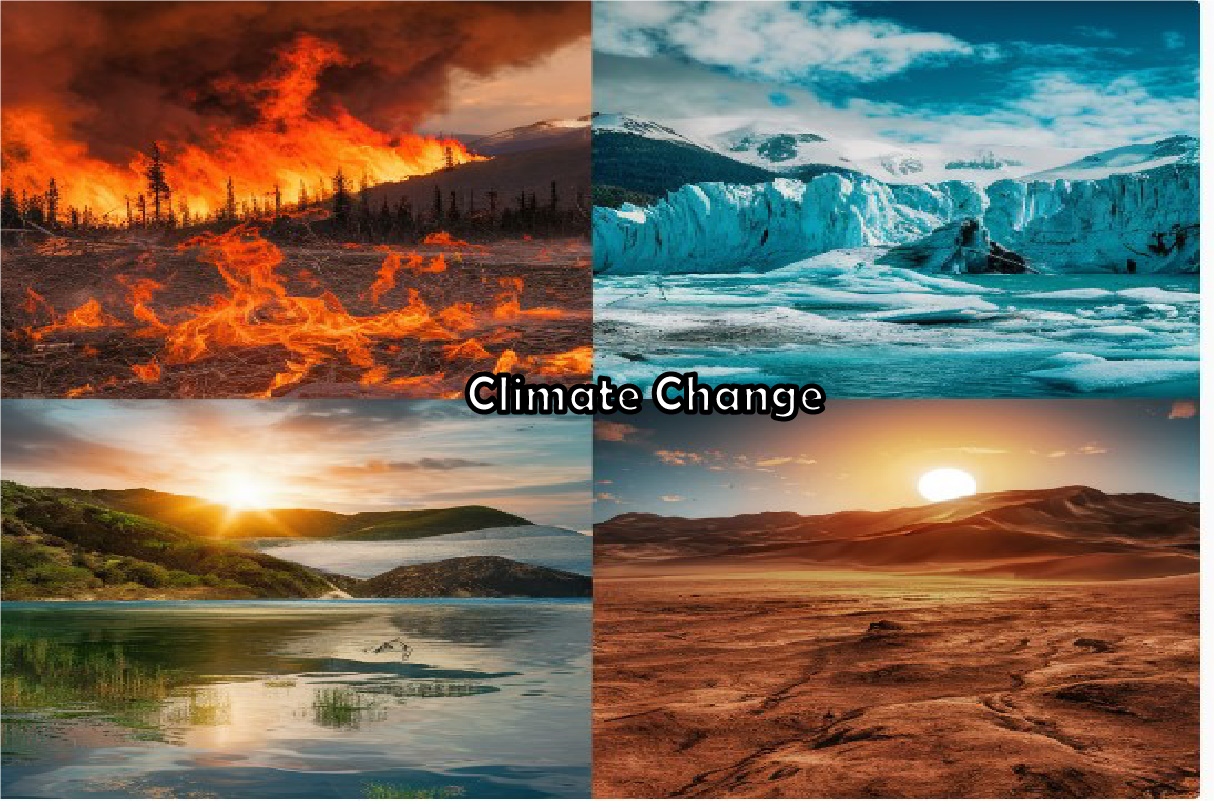One of the most important problems facing humanity right now is climate change. It refers to long-term shifts in temperatures and weather patterns, primarily due to human activities, especially the burning of fossil fuels. This blog will delve into the causes, impacts, and solutions to climate change, providing a comprehensive overview of the challenges and opportunities we face in addressing this global crisis.
The Science of Climate Change
What is Climate Change?
Significant alterations in global temperatures and weather patterns throughout time are referred to as climate change. While climate change is a natural phenomenon, current trends are largely driven by human activities. The Earth’s climate has always fluctuated, but the current rate of change is unprecedented.
The Greenhouse Effect
The Earth’s surface warms naturally due to the greenhouse effect. A portion of the solar energy that reaches Earth is reflected back into space, while the remaining portion is absorbed and re radiated by greenhouse gases. This process maintains the Earth’s temperature at around 33 degrees Celsius, which is warmer than it would otherwise be, allowing life to exist.
Human Activities and Greenhouse Gases
The amount of greenhouse gases in the atmosphere has considerably grown due to human activity since the Industrial Revolution. These activities include burning fossil fuels (coal, oil, and natural gas), deforestation, and industrial processes Methane (CH4), nitrous oxide (N2O), and carbon dioxide (CO2) are the three primary greenhouse gases.
Causes of Climate Change
Fossil Fuels
The main cause of greenhouse gas emissions is the combustion of fossil fuels for power and transportation. Coal, oil, and natural gas are used to generate electricity, heat homes, and power vehicles. This process releases large amounts of CO2, the most significant greenhouse gas.
Deforestation
As carbon sinks, forests take up CO2 from the atmosphere. However, deforestation for agriculture, logging, and urban development reduces the number of trees available to absorb CO2. This not only increases atmospheric CO2 levels but also releases stored carbon when trees are burned or decomposed.
Agriculture
Agriculture contributes to climate change through methane emissions from livestock, rice paddies, and the use of synthetic fertilizers, which release nitrous oxide. Additionally, the conversion of natural landscapes into agricultural land results in the release of stored carbon.
Industrial Processes
Industrial activities, including cement production, chemical manufacturing, and metal smelting, release significant amounts of greenhouse gases. These processes often involve the burning of fossil fuels and the release of CO2, methane, and other pollutants.
Impacts of Climate Change
Rising Temperatures
An increase in global temperatures is one of the obvious effects of climate change. According to the Intergovernmental Panel on Climate Change (IPCC), throughout the late 19th century, the average surface temperature of the Earth has increased by about 1.2 degrees Celsius. This warming trend is expected to continue, potentially with severe consequences.
Rising sea levels and ice melting
Global warming is causing an acceleration of the melting of glaciers and polar ice caps. Because of this, sea levels are rising, putting coastal communities and ecosystems at risk. The IPCC predicts that by the end of the century, sea levels might rise by up to one metre, uprooting millions of people and submerging low-lying areas.
Extreme Weather Events
Increases in the frequency and severity of extreme weather events, such as hurricanes, heat waves, droughts, and heavy rains, are associated with climate change. The effects of these occurrences on infrastructure, ecosystems, and populations can be catastrophic.
Ocean Acidification
Growing CO2 concentrations in the water as a result of rising atmospheric CO2 levels cause ocean solidification. Marine life is harmed by this process, especially species like corals, mollusks, and certain types of plankton that have calcium carbonate skeletons or shells.
Impacts on Biodiversity
Climate change is altering habitats and ecosystems, putting many species at risk. Changes in temperature, precipitation, and the timing of biological events (such as migration and reproduction) can disrupt the delicate balance of ecosystems. Some species may adapt or migrate, but others face the risk of extinction.
Human Health
Climate change has significant implications for human health. Rising temperatures can lead to heat-related illnesses and deaths, while changes in precipitation patterns can affect the spread of vector-borne diseases such as malaria and dengue fever. Injuries, fatalities, and negative effects on mental health can also arise from extreme weather occurrences.
Solutions to Climate Change
Mitigation Strategies
Mitigation strategies refer to actions and policies aimed at reducing or preventing the emission of greenhouse gases to limit the magnitude and rate of long-term climate change. These strategies include transitioning to renewable energy sources, improving energy efficiency, reforestation, and adopting sustainable agricultural practices.
Renewable Energy
Making the switch to renewable energy sources, such hydroelectric, solar, and wind power, is crucial to lowering greenhouse gas emissions. Renewable energy technologies produce little to no emissions and are becoming increasingly cost-competitive with fossil fuels.
Energy Efficiency
Emissions can be greatly decreased by enhancing energy efficiency in industry, transportation, and buildings. This entails implementing energy-saving lighting, heating, and cooling systems, appliances, and public transportation in addition to encouraging the use of electric cars.
Reforestation and Afforestation
Restoring degraded forests and planting new trees can enhance carbon sequestration and help offset emissions. Reforestation and afforestation projects also provide additional benefits, such as habitat restoration, soil conservation, and improved water quality.
Sustainable Agriculture
Adopting sustainable agricultural practices can reduce emissions from the sector. This includes practices such as no-till farming, agroforestry, and the use of organic fertilizers. Reducing food waste and shifting towards plant-based diets can also lower the carbon footprint of food production.
Adaptation Strategies
Building Resilience
Communities need to build resilience to the impacts of climate change. This involves improving infrastructure, such as flood defenses, upgrading drainage systems, and designing buildings to withstand extreme weather. Moreover, it also includes developing early warning systems and emergency response plans.
Protecting Ecosystems
Protecting and restoring natural ecosystems can enhance their resilience to climate change. This includes preserving wetlands, mangroves, and coral reefs, which provide important services such as flood protection, water filtration, and habitat for wildlife.
Water Management
Adapting to changing precipitation patterns requires effective water management strategies. This includes improving water storage and distribution systems, promoting water conservation, and implementing policies to ensure sustainable water use.
Climate-Smart Agriculture
Climate-smart agriculture involves practices that increase productivity, enhance resilience, and reduce emissions. This includes using drought-resistant crop varieties, improving soil health, and adopting water-efficient irrigation techniques.
Policy and International Cooperation
Paris Agreement
The Paris Agreement, adopted in 2015, is a landmark international treaty aimed at limiting global warming to well below 2 degrees Celsius above per-industrial levels, with efforts to limit it to 1.5 degrees Celsius. Countries commit to nationally determined contributions (NDCs) and report on their progress.
Carbon Pricing
Implementing carbon pricing mechanisms, such as carbon taxes or cap-and-trade systems, can provide economic incentives for reducing emissions. By putting a price on carbon, these mechanisms encourage businesses and individuals to adopt cleaner technologies and practices.
Environmental Regulations
Governments can implement regulations to reduce emissions and promote sustainability. This includes setting emission standards for vehicles and industries, phasing out fossil fuel subsidies, and promoting renewable energy through incentives and mandates.
International Cooperation
Addressing climate change requires global cooperation. To share resources, technology, and expertise, nations must cooperate. International organizations, such as the United Nations Framework Convention on Climate Change (UNFCCC), play a crucial role in facilitating cooperation and coordination.
The Role of Individuals in Combating Climate Change
Reducing Carbon Footprint
People are able to improve their carbon footprint. This entails conserving water, utilising public transit, utilising fewer cars, and utilising energy-efficient appliances. Even small changes, like cutting back on trash and turning off lights when not in use, can have a big impact.
Supporting Sustainable Practices
Consumers can support sustainable practices by choosing products that are environmentally friendly and socially responsible. This includes buying locally produced and organic food, reducing single-use plastics, and supporting companies that prioritise sustainability.
Advocacy and Education
Raising awareness and advocating for climate action is crucial. Individuals can get involved in local environmental groups, participate in climate marches, and engage with policymakers. Educating others about the importance of addressing climate change can help build a broader movement for action.
Sustainable Lifestyle Choices
Adopting a sustainable lifestyle can contribute to reducing emissions. This includes making energy-efficient home improvements, such as installing solar panels and using smart thermostats. Additionally, it also involves making conscious choices about diet, transportation, and consumption habits.
The Future of Climate Action
Technological Innovations
Innovations in technology will be essential to combating climate change. Advances in renewable energy, energy storage, and carbon capture and storage (CCS) technologies offer new opportunities for reducing emissions. Emerging technologies, such as hydrogen fuel cells and advanced nuclear reactors, also hold promise.
Green Economy
Transitioning to a green economy involves creating jobs and economic opportunities in sustainable industries. This includes investing in renewable energy, energy efficiency, and sustainable agriculture. Green jobs can drive economic growth while reducing environmental impact.
Youth and Climate Activism
Significant momentum is being generated for climate action by youth and climate activism. Young people around the world are demanding bold action from governments and businesses. Movements such as Fridays for Future, led by Greta Thunberg, have brought global attention to the urgent need for climate action.
Policy and Governance
Effective policy and governance are essential for driving climate action. This includes enacting strong climate legislation, setting ambitious emission reduction targets, and holding polluters accountable. Decision-making procedures that are inclusive and transparent help guarantee the efficacy and equity of policies.
Conclusion
Given the complexity and breadth of the problem, climate change demands immediate attention. Understanding the science, causes, and impacts of climate change is essential for developing effective solutions. Mitigation and adaptation strategies, supported by strong policies and international cooperation, can help address this global challenge. Individuals also have a crucial role to play in reducing emissions and advocating for climate action. By working together, we can build a sustainable and resilient future for all.











